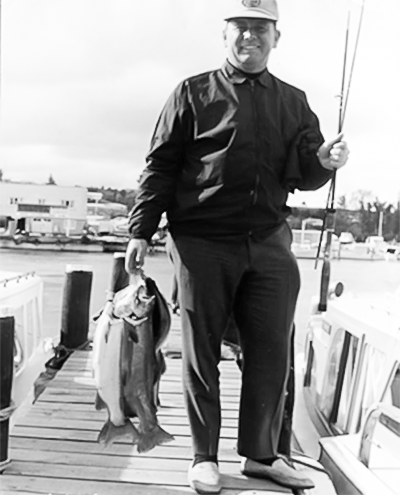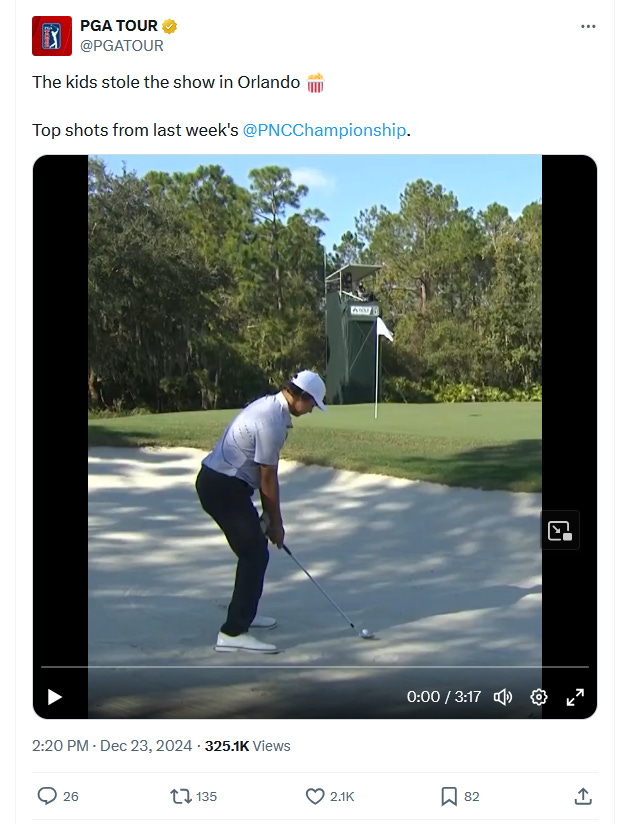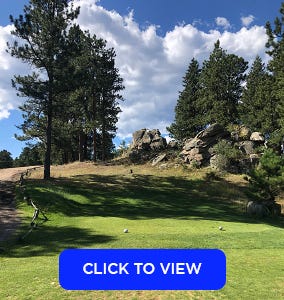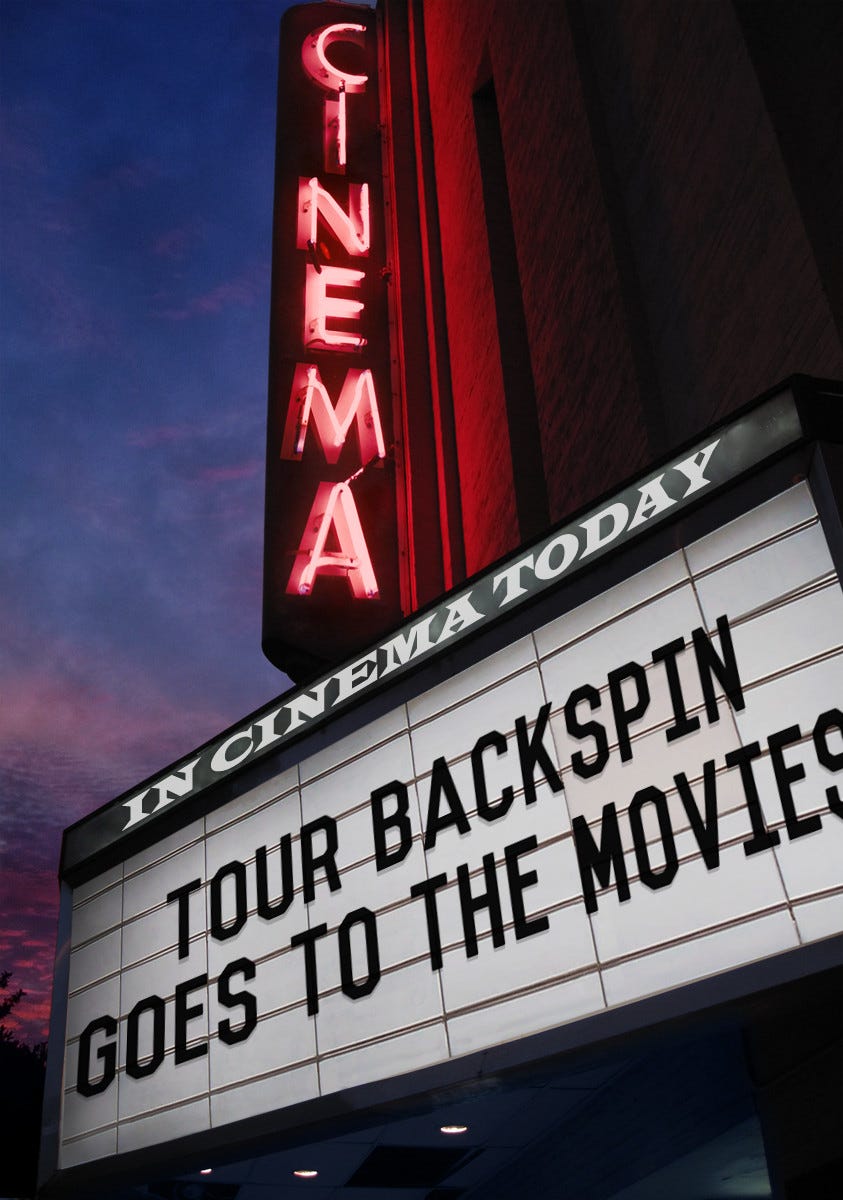Televised Exhibitions, Part Duex
Former PGA TOUR official points out omission from last week's article
We hope you had a very Merry Christmas and wish you the best for the New Year! We’re looking forward to a great golf season in 2025.
We got the idea for this week’s journey through the past from Joe Black, a former official on the PGA TOUR where he served an eight-year term as the Tournament Supervisor. He is also a member of the PGA of America Hall of Fame. Last week, we wrote about the World Series of Golf and how it ushered in the era of the televised golf exhibition matches. Joe weighed in with an email to us and pointed out we omitted a show when we referred to the different golf shows of the 1960s. We listed Shell’s Wonderful World of Golf, The CBS Golf Classic, and Big Three Golf.
Larry, what about All Star Golf?
I knew of All Star Golf, and Challenge Golf and it was just carelessness on my part for not including those shows. There isn’t much information about them online, so we took the challenge to research All Star Golf and found past episodes on The Golf Channel. We picked a match from 1960 because it featured Bob Rosburg. If you read last week’s story, it was at the 1962 World Series of Golf that Rosburg was first used as an on-course commentator during the television broadcast. Plus, his match with Tommy Bolt was an exhibition of great golf, even though the two were not particularly colorful television personas.
Scroll down to read.
Give you golf buddies the golfing gift that will be opened every week, and they will think of you. ‘Tis the season to spread joy, and what better way than to gift a subscription to your squad.
The PGA TOUR has wrapped up their year and will return January 2nd with The Sentry at Kapalua in Maui. Last week featured the PNC Championship, an unofficial event featuring family members playing in a scramble format. It proved to be quite exciting requiring a playoff between the Langers and the Woods. Scroll down for my recap and the Clips You Might Have Missed from the week.
We’re asking, “Who ya got?” in this week’s Tour Backspin Poll. The Music Clip has Maurice Williams & The Zodiaks performing “Stay” live in 1960. Tour Backspin Goes to The Movies features the theatrical trailer for “The Magnificent Seven” from 1960. Scroll down to listen and watch.
We feature “Thunderbolt” Tommy Bolt’s swing in Swing Like a Pro. Take a shot at the WHAT HOLE IS IT? this week and you could win a goody bundle of golf swag. We’ve got some links for you in the Check it Out section and an ad from 1960 for All Star Golf in this week’s Vintage Ad. Scroll down to view.
The Tour Backspin Poll
Last week, in the Tour Backspin Poll, we asked you if you watched The Showdown, the televised exhibition match between the PGA TOUR’s Rory McIlroy and Scottie Sheffeler against the LIV Golf players Bryson DeChambeau and Brooks Koepka. Seems like this exhibition did not generate much excitement as 82% of respondents did not watch and couldn’t of cared less about it, while 18% of respondents watched it and hated it. Nobody watched it and loved it. Let us know how you feel about this week’s question.
Who will get off to a fast start on the season at The Sentry Tournament of Champions? We list the favorites on the betting sites. Let us know who ya got in this week’s Tour Backspin Poll.
We’re playing Bob Rosburg Trivia in this week’s Tour Backspin Quiz. Scroll down to play.
Did you miss a previous newsletter? You can view it HERE. Help us grow Tour Backspin! Please forward this email to a friend. Was this newsletter forwarded to you? You can sign up HERE.
Okay, we're on the tee, let's get going.
Enjoy!
Larry Baush
Rosburg and Bolt Light Up La Quinta in All Star Golf Match

It is Tuesday, March 15th in 1960 and Bob Rosburg and Tommy Bolt are meeting in a stroke play match at La Quinta Country Club in La Quinta, CA. This is their third match against each other in the televised series All Star Golf, an 18-hole playoff match to determine a winner as they tied both of their previous matches. The first match was played at the Paradise Club in Crystal River, FL, and then again at La Quinta. The winner of the third match would move on to the next stage in the televised series.
According to the rules of All Star Golf, tied matches result in another match with increased stakes. Players in the televised exhibition matches earned $2,000 for the winner, and $1,000 for the loser. In the case of a tie, they played again with the winner taking home $4,000 and the loser $2,000. In case of another tie, something that had never happened since the inception of the series in 1957, the stakes again increased, this time to $6,000 for the winner and $3,000 for the loser.
So Rosburg and Bolt were playing for real money. Bolt’s win later in the year at the Memphis Open was worth $4,300, for example, so winning this match was worth more than winning some tour events.
A total of $88,500 in prize money is handed out during the series.
The matches are broadcast on the ABC network over a 26-week period beginning in the fall and running through the spring of 1961. The series opens with the first two matches played at the Champions Golf Club in Houston, TX, before moving to the Paradise Country Club in Crystal River, FL, where four matches were played, and then five matches would be played at La Quinta Country Club. The winners of the matches advanced to the round robin stage played at the Yorba Linda Country Club in Yorba Linda, CA, with the winner receiving $10,000. A total of $88,500 in prize money is handed out during the series.
A crew of 52 men utilized seven cameras and will spend about seven hours shooting 20,000 feet of film that will be edited down to 2,000 feet for each broadcast of a match. Five of the cameras are set up at the tee, one is set up in the fairway at the most likely distance where drives would land, and the seventh camera was located at the green on a high hydraulic lift.

The director, Sidney Goltz, managed the chaotic scene as the production crew works on the right side of each hole while a small gallery is marshaled down the left side of the fairway. After the players hit their tee shots, the cameras at the tee are moved down and set up around the approach shot and the fairway camera is moved to the green. Cars were employed to move the cameras and can often been seen in the background while the play is being filmed. Once the approach shots are hit, the cameras are moved to the green.
“We found that if we stopped one of the cameras, the players could tell the difference in the noise.”
Around the green, all seven cameras are running at the same time.
“We found that if we stopped one of the cameras, the players could tell the difference in the noise,” Don Hill, the art director and unit manager explained to Golf Digest in the November 1960 issue. “The cameras kept on rolling even if one or more of them runs out of film, and when a player a player takes quite a bit of time to get his chip or putt off, we can use an awful lot of film.”
The play-by-play action of the match was called live by Jimmy Demaret who utilized a setup that held his microphone on his chest leaving his hands free to keep score and take notes. Demaret explained how the players would play certain shots or why a shot turned out the way it did.

Once the match is completed, the monumental job of editing it down to fit within an hour broadcast for television. Graphics showing the layout of holes, including some of the shots, mostly drives, are added to help condense the action.
In 1960, the action was recorded in black and white while the matches were recorded in color starting in 1961. The difference is dramatic with the beauty of the courses on display on television screens around the country during the cold winter months.
Rosburg and Bolt are both dressed in the latest fashions including alpaca sweaters even though they are playing in the desert. Bolt looks very fashionable with his athletic build compared to Rosburg who is a bit chubby in build. Many of the male spectators are dressed in Bermuda shorts while the women sport cat eye sunglasses.

For Rosburg to make it to this third match, he made two long putts on the 17th and 18th holes to tie Bolt in the second match. Rosburg used an Acushnet Bullseye blade, and he continued to putt well in the third match. Bolt used a putter with a distinctive bend to the shaft that arched back towards him. Both players used a short, stabbing stroke that was effective on the slow grainy greens.
Both players hit their approach shots into the first green close to the pin, almost the identical distance from the hole. In fact, a tape measure must be employed to determine who is away and will putt first. Rosburg holds the end of the tape measure at the hole while an official holds the other and Bolt observes, very closely, the measurement. It is determined that Bolt is away, and he misses his putt while Rosburg curls his putt in for a birdie, and a one-stroke lead.

Bolt evens the match up on the 4th hole with a birdie after sinking a 12-foot, downhill putt. After the ball drops into the cup, Bolt runs up to the hole and places his hand over the cup, a humorous gesture to ensure the ball remained in the hole.
On the 5th hole, a 505-yard, par-5, Rosburg records a birdie after coming out of the sand near the green on his third shot. Bolt misses his birdie putt and Rosburg regains his one-shot lead. Bolt answers with a birdie of his own on the 6th hole, another par-5, and the match is once again all-square.
Rosburg stuffed his shot at the par-3, 7th hole and made the short birdie putt to again go one-stroke ahead in the match. The lead remains at one-stroke as the players make the turn with Rosburg shooting a three-under 33 while Bolt recorded a two-under 34.
Bolt bogeyed the 11th hole, a par-5, to drop two shots behind Rosburg, but Rosburg bogeyed the 12th hole to drop a stroke to Bolt and the lead was again one-shot. Rosburg birdies the 17th hole for a two-shot lead and with both players making par at the final hole, Rosburg wins the match with a five-under par 67 to Bolt’s three-under 69.
The players and Demaret gather at the side of the green where Demaret presents the checks, which had been folded in half, to the players. Bolt received his $3,000 check and then commented on how well Rosburg played before Rosburg receives his $6,000 check.

The first match between Rosburg and Bolt aired on November 19th, 1960, the second match on December 4th, 1960, and the third match on December 10, 1960.
Even though it was an exhibition match, both players were very serious during the round and the level of play was exceptional. Even in black-and-white, the scene in the desert was beautiful and there was a very country club feel to the day. Golf fans denied a chance to play during the cold winter months around the country could tune in and escape to the sunny climate while watching a very high caliber of golf and listening to the dulcimer tones of Demaret’s play-by-play. And the players enjoyed a fine payday for their efforts after playing in the first double playoff in All Star Golf history.
BONUS STORY
La Quinta Country Club opened for play in November of 1957. The mostly flat course measured 6,949 yards and played to a par of 72. It featured palm trees, and three artificial lakes. The lakes provided a special attraction to Billy Casper.
As an enthusiastic fisherman, Casper enjoyed the fact that in non-competitive rounds he could pack his rod and reel and take a break and fish. He was thrilled with the excellent results from the three lakes.
WHAT HOLE IS IT?
Congratulations to Donald Gorman for winning the WHAT HOLE IS IT? contest last week by correctly identifying #15 at La Quinta Resort Club, Mountain Course, in La Quinta, CA. Donald beat out seven other correct answers in the drawing and we’ve got a prize pack of golf swag on the way to him.
We also had a notable entry last week as Johnny Pott, former player on the PGA TOUR, correctly answered WHAT HOLE IS IT? He also provided some inside information on the hole as he was the marketing director at PGA West for Landmark Golf, the developer of the La Quinta Resort Club.
Pete Dye didn’t charge to build 12-15. He was excited with the possibilities of the land features.
We understand if a premium subscription isn’t in the budget, and we’re happy to have you here however you’ve arrived. You can sign up for a free subscription so you’ll never miss the newsletter. It will arrive in your inbox every Thursday. Paid subscribers help fund the work we do here at Tour Backspin.
We told you about getting our hands on a treasure trove of film that we are cleaning up and digitizing for the Tony Lema documentary. Some great footage of Tony in action and even home movies. The work is paying off with good results. We’ve got a new sample coming next week. Check it out (clicking on link will open this post on the web, scroll down to video player).
PGA TOUR Wrap-Up | PNC Championship
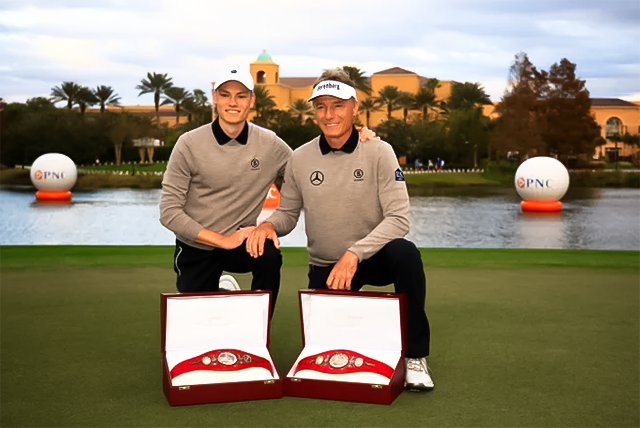
The Langer team, consisting of Bernhard and his son Jason, won the PNC Championship in a one-hole playoff over the team of Team Woods. The Langers defended their title when Bernhard eagled the first playoff hole after both teams finished regulation play at 28-under-par.
Charlie Woods got his first hole-in-one, one of two aces on the day. The other ace belonged to Paddy Harrington.
Top Ten shots at the PNC.
Clips You Might Have Missed
Charlie’s Ace.
John Daly is ready to go.
Scottie’s year in-depth.
John Daly and Tiger at the PNC
Tour Backspin Quiz | Bob Rosburg Trivia
How many official PGA TOUR wins did Bob Rosburg record?
Scroll down for answer
Swing Like a Pro
Tommy Bolt hits out of a bunker during his third match against Bob Rosburg in 1960 on the All Star Golf television series.
Blind Shot
Click for something fun. 👀
TaylorMade’s roster poses in iconic Christmas movie posters. Greg Gottfried of Golf Digest has the details.
Tour Backspin Music Clip
Maurice Williams & The Zodiacs doing “Stay” live in 1960.
Tour Backspin Quiz Answer:
Bob Rosburg won six times on the PGA TOUR including the 1959 PGA Championship. He also won the 1954 Miami Open, the 1956 Motor City Open, the 1956 Convair-San Diego Open, the 1961 Bing Crosby National Pro-Am, and the 1972 Bob Hope Desert Classic.
Thank you for reading this far, I know your time is valuable and choosing to spend some of it on what I’ve created is gratifying. If you want to help support the work we’re doing, please consider upgrading. It’s just $36 a year and you’ll be helping to tell the stories from one of golf’s golden ages.
Vintage Ad
Final Thoughts
That theme song for The Magnificent Seven is so great. “The were only seven, but they fought like 700.”
We enjoyed a couple of days in Maui. Watch for course reviews coming soon.







